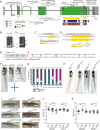The Golgi matrix protein giantin is required for normal cilia function in zebrafish
- PMID: 28546340
- PMCID: PMC5576078
- DOI: 10.1242/bio.025502
The Golgi matrix protein giantin is required for normal cilia function in zebrafish
Abstract
The Golgi is essential for glycosylation of newly synthesised proteins including almost all cell-surface and extracellular matrix proteoglycans. Giantin, encoded by the golgb1 gene, is a member of the golgin family of proteins that reside within the Golgi stack, but its function remains elusive. Loss of function of giantin in rats causes osteochondrodysplasia; knockout mice show milder defects, notably a cleft palate. In vitro, giantin has been implicated in Golgi organisation, biosynthetic trafficking, and ciliogenesis. Here we show that loss of function of giantin in zebrafish, using either morpholino or knockout techniques, causes defects in cilia function. Giantin morphants have fewer cilia in the neural tube and those remaining are longer. Mutants have the same number of cilia in the neural tube but these cilia are also elongated. Scanning electron microscopy shows that loss of giantin results in an accumulation of material at the ciliary tip, consistent with a loss of function of retrograde intraflagellar transport. Mutants show milder defects than morphants consistent with adaptation to loss of giantin.
Keywords: Cilia; Golgi; Golgi matrix; Zebrafish.
© 2017. Published by The Company of Biologists Ltd.
Conflict of interest statement
Competing interestsThe authors declare no competing or financial interests.
Figures





Similar articles
-
Regulator of calcineurin-2 is a centriolar protein with a role in cilia length control.J Cell Sci. 2018 May 4;131(9):jcs212258. doi: 10.1242/jcs.212258. J Cell Sci. 2018. PMID: 29643119 Free PMC article.
-
A role for the Golgi matrix protein giantin in ciliogenesis through control of the localization of dynein-2.J Cell Sci. 2013 Nov 15;126(Pt 22):5189-97. doi: 10.1242/jcs.131664. Epub 2013 Sep 17. J Cell Sci. 2013. PMID: 24046448 Free PMC article.
-
Giantin is required for coordinated production of aggrecan, link protein and type XI collagen during chondrogenesis.Biochem Biophys Res Commun. 2018 May 15;499(3):459-465. doi: 10.1016/j.bbrc.2018.03.163. Epub 2018 Mar 27. Biochem Biophys Res Commun. 2018. PMID: 29577904
-
Regulation of polycystin expression, maturation and trafficking.Cell Signal. 2020 Aug;72:109630. doi: 10.1016/j.cellsig.2020.109630. Epub 2020 Apr 8. Cell Signal. 2020. PMID: 32275942 Free PMC article. Review.
-
Trafficking of ciliary membrane proteins by the intraflagellar transport/BBSome machinery.Essays Biochem. 2018 Dec 7;62(6):753-763. doi: 10.1042/EBC20180030. Print 2018 Dec 7. Essays Biochem. 2018. PMID: 30287585 Free PMC article. Review.
Cited by
-
Rgp1 contributes to craniofacial cartilage development and Rab8a-mediated collagen II secretion.Front Endocrinol (Lausanne). 2023 Feb 9;14:1120420. doi: 10.3389/fendo.2023.1120420. eCollection 2023. Front Endocrinol (Lausanne). 2023. PMID: 36843607 Free PMC article.
-
Giantin-knockout models reveal a feedback loop between Golgi function and glycosyltransferase expression.J Cell Sci. 2017 Dec 15;130(24):4132-4143. doi: 10.1242/jcs.212308. Epub 2017 Nov 1. J Cell Sci. 2017. PMID: 29093022 Free PMC article.
-
Regulator of calcineurin-2 is a centriolar protein with a role in cilia length control.J Cell Sci. 2018 May 4;131(9):jcs212258. doi: 10.1242/jcs.212258. J Cell Sci. 2018. PMID: 29643119 Free PMC article.
-
The role of the Golgi apparatus in disease (Review).Int J Mol Med. 2021 Apr;47(4):38. doi: 10.3892/ijmm.2021.4871. Epub 2021 Feb 4. Int J Mol Med. 2021. PMID: 33537825 Free PMC article. Review.
-
A Rare Mutation in SMAD9 Associated With High Bone Mass Identifies the SMAD-Dependent BMP Signaling Pathway as a Potential Anabolic Target for Osteoporosis.J Bone Miner Res. 2020 Jan;35(1):92-105. doi: 10.1002/jbmr.3875. Epub 2019 Nov 14. J Bone Miner Res. 2020. PMID: 31525280 Free PMC article.
References
-
- Asante D., Maccarthy-Morrogh L., Townley A. K., Weiss M. A., Katayama K., Palmer K. J., Suzuki H., Westlake C. J. and Stephens D. J. (2013). A role for the Golgi matrix protein giantin in ciliogenesis through control of the localization of dynein-2. J. Cell Sci. 126, 5189-5197. 10.1242/jcs.131664 - DOI - PMC - PubMed
-
- Cermak T., Doyle E. L., Christian M., Wang L., Zhang Y., Schmidt C., Baller J. A., Somia N. V., Bogdanove A. J. and Voytas D. F. (2011). Efficient design and assembly of custom TALEN and other TAL effector-based constructs for DNA targeting. Nucleic Acids Res. 39, e82 10.1093/nar/gkr218 - DOI - PMC - PubMed
Grants and funding
LinkOut - more resources
Full Text Sources
Other Literature Sources
Molecular Biology Databases

